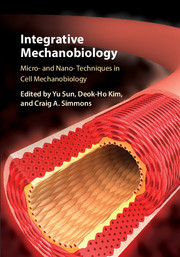Book contents
- Integrative Mechanobiology
- Integrative Mechanobiology
- Copyright page
- Contents
- Contributors
- Preface
- Part I Micro-nano techniques in cell mechanobiology
- 1 Nanotechnologies and FRET imaging in live cells
- 2 Electron microscopy and three-dimensional single-particle analysis as tools for understanding the structural basis of mechanobiology
- 3 Stretchable micropost array cytometry
- 4 Microscale generation of dynamic forces in cell culture systems
- 5 Multiscale topographical approaches for cell mechanobiology studies
- 6 Hydrogels with dynamically tunable properties
- 7 Microengineered tools for studying cell migration in electric fields
- 8 Laser ablation to investigate cell and tissue mechanics in vivo
- 9 Computational image analysis techniques for cell mechanobiology
- 10 Micro- and nanotools to probe cancer cell mechanics and mechanobiology
- 11 Stimuli-responsive polymeric substrates for cell-matrix mechanobiology
- Part II Recent progress in cell mechanobiology
- Index
- References
1 - Nanotechnologies and FRET imaging in live cells
from Part I - Micro-nano techniques in cell mechanobiology
Published online by Cambridge University Press: 05 November 2015
- Integrative Mechanobiology
- Integrative Mechanobiology
- Copyright page
- Contents
- Contributors
- Preface
- Part I Micro-nano techniques in cell mechanobiology
- 1 Nanotechnologies and FRET imaging in live cells
- 2 Electron microscopy and three-dimensional single-particle analysis as tools for understanding the structural basis of mechanobiology
- 3 Stretchable micropost array cytometry
- 4 Microscale generation of dynamic forces in cell culture systems
- 5 Multiscale topographical approaches for cell mechanobiology studies
- 6 Hydrogels with dynamically tunable properties
- 7 Microengineered tools for studying cell migration in electric fields
- 8 Laser ablation to investigate cell and tissue mechanics in vivo
- 9 Computational image analysis techniques for cell mechanobiology
- 10 Micro- and nanotools to probe cancer cell mechanics and mechanobiology
- 11 Stimuli-responsive polymeric substrates for cell-matrix mechanobiology
- Part II Recent progress in cell mechanobiology
- Index
- References
Summary
Live cells can sense the mechanical characteristics of the microenvironment and translate the mechanical cues to intracellular biochemical signals in physiology and disease. To investigate intracellular signaling transduction during mechanosensing, nanotechnologies, and FRET live-cell imaging technologies have been developed to visualize the output signals in real time, such as intracellular molecular activity. Meanwhile, micropatterned technologies have been applied to modulate the physical and mechanical environment surrounding the cell to fine-tune the input signals in cellular mechanosensing. These advanced technologies can join forces and shed new light into the molecular networks that control mechanotransduction in normal conditions and disease.
- Type
- Chapter
- Information
- Integrative MechanobiologyMicro- and Nano- Techniques in Cell Mechanobiology, pp. 3 - 14Publisher: Cambridge University PressPrint publication year: 2015



